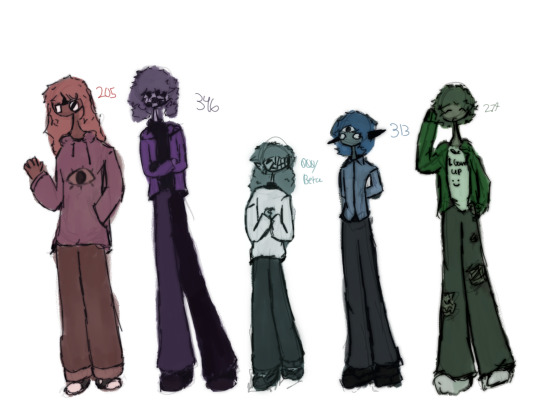#1479
Text









›› icons made by nebular-te.
⌕ coloring psd 1479 by gmfioart
#1479#psd#coloring#psd coloring#old#old photography#sepia#texture#jujutsu kaisen icons#jujutsu kaisen#geto suguru#suguru geto#icons#aesthetic#icon#photoshop#photopea#geto suguru icons#suguru geto icons#gmfioart
77 notes
·
View notes
Text

65 notes
·
View notes
Photo

Day 1479 - A real section of dyke on Offa’s Dyke path
#dyke#history#landscape#view#Offa's Dyke#path#trail#walk#walking#hike#hiking#tree#Powys#Wales#Cymru#sky#UK#1479
53 notes
·
View notes
Audio
4 notes
·
View notes
Text
youtube

Release: May 1, 1982
Lyrics:
I don't want to dance
Dance with you baby no more
I'll never do something to hurt you, though
Oh but the feeling is bad
The feeling is bad
I love your personality
But I don't want our love on show
Sometimes I think it's insanity
Girl the way you go
With all of the guys on the corner
Oh baby, you're the latest trick
Oh, you seem to have their number
Look they're dancing still
I don't want to dance
Dance with you baby no more
I'll never do something to hurt you, though
Oh but the feeling is bad
The feeling is bad
Baby now the party's over
For us, so I'll be on my way
Now that the things which moved me
Are standing still
I know it's only superstition
Baby, but I won't look back
Even though I feel your music
Baby that is that
I don't want to dance
Dance with you baby no more
I'll never do something to hurt you, though
Oh but the feeling is bad
The feeling is bad
Don't want to dance
Don't want to dance
Don't want to dance
Don't want to dance
Don't want to dance
Don't want to dance
Don't want to dance
Songwriter: Eddy Grant
I don't want to dance
Dance with you baby no more
I'll never do something to hurt you, though
Oh but the feeling is bad
The feeling is bad
SongFacts:
👉📖
Homepage:
Eddy Grant
#new#new music#my chaos radio#Eddy Grant#I don't wanna dance#music#spotify#youtube#music video#youtube video#good music#hit of the day#video of the day#80s#80s music#80s nostalgia#80s video#80s charts#1982#pop#reggae#r&b/soul#pop rock#lyrics#songfacts#1479
1 note
·
View note
Text


ELLE No.1479 - 22 April 1974 - Carole Singleton
1 note
·
View note
Text
Comprehensive Dead Three Timeline
Outdated! I've made a new timeline!
Obviously there's varying amounts of speculation here, but I believe this is as close to a reasonable order of events as can be achieved with current, in-game information
1460s
Enver Flymm sold to Raphael by his parents, renamed Gortash
Gortash learns about the Crown of Karsus while a prisoner of Raphael
1470s
Gortash escapes the House of Hope
Gortash gets involved with black market arms dealing
Durge begins their serial killing spree in Baldur’s Gate
The Emperor dominates Duke Stelmane
1480s
Gortash establishes a cult of Bane in Baldur’s Gate
Gortash approaches Durge about an alliance
Hall of Wonders test mission
- Durge gets Bhaalist memorabilia
- Gortash gets a bunch of Gondian designs
- Durge & Gortash get companionship
Gortash trades Karlach to Zariel for infernal machinery & iron
Baldur’s Gate’s Beloved Ranger statue goes missing
Gortash recruits Franc Peartree to distribute infernal iron weapons
Gortash moves against the Zhentarim & Knights of the Shield
Wyll Ravengard enters pact with Mizora, leaves Baldur’s Gate
1490s
Dead Three made aware of the Crown of Karsus (most likely informed by Gortash)
- Gortash becomes Bane’s Chosen
- Durge becomes Bhaal’s chosen
- Gortash & Durge are instructed to recruit Ketheric
Gortash tells Durge about the Crown of Karsus
They visit Ketheric and learn of the illithid colony under Moonrise
Gortash & Durge visit the House of Hope (for intel on Mephistar?)
Gortash & Durge raid Mephistar
- They get the Crown of Karsus
- They get the book on the accelerated grand design
Gortash captures the Emperor
Gortash & Durge return to Moonrise
- Their identities are kept secret from Ketheric’s people
- Durge impresses the Moonrise Gnolls, but not Steelclaw
- Ketheric yells at Durge in the throne room for unknown reason
Durge proposes their plan to the Elder Brain who accepts
Raid on the illithid colony
- Durge puts the Crown on the Elder Brain
- Orin gets Durge alone during the raid & stabs them in the head
- Orin tadpoles Durge, making them the first True Soul
- Orin leaves Durge in an illithid pod
- Orin tells the Chosen she now speaks for the Temple of Bhaal
- Orin likely told Gortash, Ketheric, and Balthazar something vague about Durge’s disappearance being related to Durge’s religious crisis and let their imaginations do the rest
1492
Durge breaks out of their pod & is found by Kressa Bonedaughter
Gortash gets weird and intense with unethical experiments
- Some futzing to get the tadpoles to consistently remain in stasis
- This is when the name ‘True Souls’ gets coined
- Extremely questionable fun with brains
- Getting the Absolute’s voice sorted out
- Tadpoling his parents
- Poorly conceived experiments on children & their parents
Isobel is resurrected by the Dead Three
Minsc captured by Absolutists at recruitment rally in the Undercity
Minthara Baenre is recruited by Orin and Ketheric
Gortash has the Iron Throne converted to hold hostages
Gortash presents prototype Steel Watcher to the city council
Jaheira tracks cult to shadow-cursed land, meets Isobel
Elturel falls into Avernus
The brain sends the Chosen dreams about the Astral Prism
Gortash researches the Prism, finds out that Vlaakith has it
Gortash tells Ketheric to send a team to get the Prism
- A nautiloid piloted by the Emperor and other illithid is sent
- Kressa’s husband arranged for Durge to be on the nautiloid
Gortash deploys Steel Watch in Lower/Outer City
At this point Elturel is no longer in Avernus
Nautiloid picks up Shadowheart & the Prism from Astral Plane
Nautiloid picks up Lae’zel (?)
Nautiloid picks up Gale (?) & Astarion in Baldur's Gate
Nautiloid picks up Karlach & Wyll in Avernus
Nautiloid crashes, game begins
#bg3#bg3 spoilers#bg3 timeline#The Dead Three#Lord Enver Gortash#Ketheric Thorm#Orin the Red#The Dark Urge#The Emperor#Shadowheart#Lae'zel of K'liir#Gale of Waterdeep#Gale Dekarios#Astarion Ancunin#Karlach Cliffgate#Wyll Ravengard#The Blade of Frontiers#High Harper Jaheira#Minsc of Rashemen#If you want older Gortash you can have him sold in the 50s and escape in the 60s#but I don't think he's older than 40 based on I'm 41 and his parents look younger than my parents#I tried not to editorialize#but I failed#Durge killing spree began in 1477#Duke Stelmane became the Emperor's thrall in 1479#Karlach was sold in 1482#Beloved Ranger statue disappeared in 1482#Wyll pacted to Mizora in 1485#Nautiloid crashed 20 Eleasias 1492
759 notes
·
View notes
Text


~ Finger stall.
Period: New Kingdom, Dynasty 18; reign of Thutmose III
Date: ca. 1479–1425 B.C.
Place of origin: Egypt, Upper Egypt, Thebes, Wadi Gabbanat el-Qurud, Wadi D, Tomb of the Three Foreign Wives of Thutmose III
Medium: Gold
#ancient#ancient art#history#museum#archeology#ancient egypt#ancient sculpture#ancient history#archaeology#egyptology#egyptian#egypt#finger stall#finger#18th dynasty#new kingdom#thutmose iii#thebes#ca. 1479 b.c.#ca. 1425 b.c.#gold
457 notes
·
View notes
Text

Artist's Painting of a Hippopotamus
Ca. 1479–1425 B.C.
New Kingdom.
The hippopotamus on this ostracon was painted with the sure hand of a skilled artist who had no need of a grid. Other ostraca in the collection were clearly made as templates to be used when transferring an image to the wall of a tomb or a temple or as practice pieces. The purpose for this sketch and others is less clear.
#Artist's Painting of a Hippopotamus#Ca. 1479–1425 B.C.#new kingdom#art#atist#art work#art world#art news#ancient art#archeology#archeolgst#history#history news#ancient history#ancient culture#ancient civilizations#ancient egypt#egyptian history#egyptian mythology#egyptian art
172 notes
·
View notes
Text
"[Elizabeth Woodville's] piety as queen seems to have been broadly conventional for a fifteenth-century royal, encompassing pilgrimages, membership of various fraternities, a particular devotion to her name saint, notable generosity to the Carthusians, and the foundation of a chantry at Westminster after her son was born there. ['On other occasions she supported planned religious foundations in London, […] made generous gifts to Eton College, and petitioned the pope to extend the circumstances in which indulgences could be acquired by observing the feast of the Visitation']. One possible indicator of a more personal, and more sophisticated, thread in her piety is a book of Hours of the Guardian Angel which Sutton and Visser-Fuchs have argued was commissioned for her, very possibly at her request."
-J.L. Laynesmith, "Elizabeth Woodville: The Knight's Widow", "Later Plantagenet and Wars of the Roses Consorts: Power, Influence, Dynasty"
#historicwomendaily#elizabeth woodville#my post#friendly reminder that there's nothing indicating that Elizabeth was exceptionally pious or that her piety was 'beyond purely conventional'#(something first claimed by Anne Crawford who simultaneously claimed that Elizabeth was 'grasping and totally lacking in scruple' so...)#EW's piety as queen may have stood out compared to former 15th century predecessors and definitely stood out compared to her husband#but her actions in themselves were not especially novel or 'beyond normal' and by themselves don't indicate unusual piety on her part#As Laynesmith's more recent research observes they seem to have been 'broadly conventional'#A conclusion arrived at Derek Neal as well who also points out that in general queens and elite noblewomen simply had wider means#of 'visible material expression of [their] personal devotion' - and also emphasizes how we should look at their wider circumstances#to understand their actions (eg: the death of Elizabeth's son George in 1479 as a motivating factor)#It's nice that we know a bit about Elizabeth's more personal piety - for eg she seems to have developed an attachment to Westminster Abbey#It's possible her (outward) piety increased across her queenship - she undertook most of her religious projects in later years#But again - none of them indicate the *level* of her piety (ie: they don't indicate that she was beyond conventionally pious)#By 1475 it seems that contemporaries identified Cecily Neville as the most personally devout from the Yorkist family#(though Elizabeth and even Cecily's sons were far greater patrons)#I think people also assume this because of her retirement to Westminster post 1485#which doesn't work because 1) we don't actually know when she retired? as Laynesmith says there is no actual evidence for the traditional#date of 12 February 1487#2) she had very secular reasons for retiring (grief over the death of her children? her lack of dower lands or estates which most other#widows had? her options were very limited; choosing to reside in the abbey is not particularly surprising. it's a massive and unneeded jump#to claim that it was motivated solely by piety (especially because it wasn't a complete 'retirement' in the way people assume it was)#I think historians have a habit of using her piety as a GOTCHA!' point against her vilification - which is a flawed and stupid argument#Elizabeth could be the most pious individual in the world and still be the pantomime villain Ricardians/Yorkists claim she was#They're not mutually exclusive; this line of thinking is useless#I think this also stems from the fact that we simply know very little about Elizabeth as an individual (ie: her hobbies/interests)#certainly far less than we do for other prominent women Margaret of Anjou; Elizabeth of York;; Cecily Neville or Margaret Beaufort#and I think rather than emphasizing that gap of knowledge her historians merely try to fill it up with 'she was pious!'#which is ... an incredibly lackluster take. I think it's better to just acknowledge that we don't know much about this historical figure#ie: I do wish that her piety and patronage was emphasized more yes. but it shouldn't flip too far to the other side either.
26 notes
·
View notes
Photo

Day 1479 - a gate, a view and a bit of dyke
14 notes
·
View notes
Text

Artist's Sketch of a Swallow
Egypt, around 1479–1458 B.C.
source
#found by kino#Limestone#Egypt#Metropolitan Museum of Art#Africa#Thebes#Upper Egypt#Ostraka#ca. 1479–1458 B.C.#paint#art history#drawing on a rock#sketch#bird#swallow
40 notes
·
View notes
Text

The Fall of Man and The Lamentation, 1479(?)
Hugo Van Der Goes
#hugo van der goes#religious art#detail#art#idk when this was painted#everything I find says ‘after 1479’ so
9 notes
·
View notes
Text

Erm. Get redesigned/finally given a final design because half of these guys existed in doodles only for months. Yes I will be doing the others just wanted to get these fuckers (directed at 313 specifically) done first :3
#Me when I still am very in love with the concept of like all of the CDs#So enjoy all of the silly little guys (and singular bitchass motherfucker (I hate 313 can you tell))#Fate and narrative#Next areeeee ummmm wsit#3013 2587 1684 1479 and 404. Don’t ask why I put them in that order#And then the final batch will hopefully be: 333 440 2888 and 835-597 (yes that is one CD—there’s this whole thing I’ll explain it if asked)#Oh yeah and one mystery design that will be a shadow in the third page because they haven’t been introduced yet :3#S.K draws
8 notes
·
View notes
Note
TELL ME ABOUT AMY POND AND VAMPIRISM AND DON'T HOLD BACK (I have yet to answer one of your Amy x Dracula asks so I'm hyped about that too!!!!)
OK!!! AMY + VAMPIRISM (or, more accurately, vampiric traits)!!!!
taking this FAR too seriously and breaking out the various essays+articles about vampirism to make this post!!! and I imagine it will be egregiously long but heyho!!!
Paul Barber outlines four different ways a person can become a vampire in Vampires, Burial, and Death: Folklore and Reality:

Amy definitely fits into these categories:
Predisposition - "people who are different, unpopular, or great sinners are apt to return from the dead. (P. Barber)" "one universally recognised member of this category would be the suicide. (J.A Thilmany)" - Amy, the local mad girl, who both hints at suicidal thoughts during her time as companion ("Listen to me. I understand. Really, I do.") and actually commits suicide, on various occasions (Amy's Choice, The Girl Who Waited, The Angels Take Manhattan) AND comes back from the dead in some form or another on those occasions and others....if anyone matches the description of those predisposed to vampirism, it's her.
Predestination - "frequently people become revenants through no fault of their own" "a revenant is born with two hearts, one of which is dedicated to the destruction of humanity." (P. Barber) - those predestined to become vampiric are often people who come from "abnormal" parentage, Amy's parents Do Not exist when we first meet her. And, even when they have been brought back, they only show up in part of one episode before becoming non-entities again (it's a flaw in the writing more than anything else but it still emphasises her "abnormal parentage").
"a revenant is bloody and blood is red; redness, therefore, must predispose toward vampirism." (P. Barber) - The redness is an obvious link: red hair, red clothes, the red houses, the apple....she's red.
Events - "people become vampires by being bitten by one." (P. Barber) - She's bitten by a Saturnyne Vampire in The Vampires of Venice.
Nonevents - "Lack of burial is itself, then, a sufficient reason for murder victims and suicides to become revenants" "another common explanation for their transformation is that they have not lived out their allotted span of life." - In most of Amy's deaths, she goes unburied. Again, this is usually because she's due to be revived but that only really emphasises the connection. In the one case where she is buried, TATM, she's a victim of the Weeping Angels; their whole thing is feeding off the potential life that their prey leaves behind, the life unlived, thus, she does not live out her allotted span of life.
So, Amy fulfils each category of the causes of Vampirism.
----
She also displays various "vampiric traits" - the main one being the idea that those afflicted with vampirism become locked in one phase of their life/body, never able to grow up past the point of their turning.
Similarly, Amy never quite moves past her garden, her waiting. A big component of her character is that she can't let go of the Doctor + her childhood. Though the writers claim she does, they never go past just saying it, we're given very little reason for her abandoning her faith in the Doctor. In fact, they often emphasise the opposite (the shot of her waiting at a window at the end of The God Complex, the S7 promo where she's pictured waiting at a phone for the doctor to call, "is it bad that I've really missed this?" in AoTD, "I can't not wait for you." in DoaS.). It's arguable that she remains trapped in this phase of waiting/hoping for 11's return up until her death. Even in some of TATM's deleted dialogue, she expresses a worry that he'll stop coming back for her out of boredom.
Just as a vampire is stuck in the body that they had at the time of their turning - Amy is stuck waiting for the Doctor for her entire run as companion.
Another of her vampiric traits is summed up by J.A Thilmany in “Draining life forces: Vampirism in Emily Bronte's Wuthering Heights”:

Amy’s last proper appearance on the show takes place inside the TARDIS, though she dies outside of it. She returns to her home as a ghost, or a daydream.
A slightly different take on the above trend is presented by Nina Auerbach in “Our Vampires, Ourselves”:

The “confined space” in Amy’s story is the garden that she constantly returns to. It ties in with her vampiric inability to move on/grow up as the garden is the home of her waiting. She can’t escape “the girl who waited”, because she often doesn’t try to - instead choosing to return to the garden (as she does in TGWW).
Returning to her final scene on the show, her appearance right at the end of 11′s life presents another vampiric trait. The scene echoes one from TATM where Amy is present for an older Rory’s death, holding his hand as he dies.
In both instances, Amy is the figure marking the death of one of her loved ones, mirroring this trait referenced by Barber:

And again by Thilmany:

Amy’s presence in both scenes is presented as the thing allowing Rory and 11 to pass on. They see her again, meaning they can die somewhat peacefully. Obviously, this isn’t a feeding as presented by the two extracts above but the scenes present something equivalent to that.
Another feature of final the scene that presents a vampiric trait is the fact that it’s not actually Amy, the figure is strongly implied to be a figment of 11′s imagination. This mimics another idea outlined by Barber:

Amy is still buried in New York, but an apparition of her is in the TARDIS performing her equivalent to feeding.
----
Having outlined how Amy fulfils both the causes of vampirism + the traits of traditional vampires, the last thing to talk about is the transformation that is characteristic of vampire mythology, particularly the transformation presented alongside women vampires.
As most of Amy’s vampiric traits link back to the Doctor, it makes sense to argue that his introduction into her life is what marks her “turning”.
When 11 meets her, she’s a child, and so she’s “pure” and “virtuous”. She’s the fairytale girl. She’s not entirely “perfect” and she presents the traits of those predisposed to vampirism: she’s from abnormal parentage/familial history (”I don't have a mum and dad. Just an aunt.”), she’s othered + different to the residents of Leadworth (”the Scottish girl in the English village”) and she presents a connection to supernatural (or preternatural) forces (”at night there's voices”).
So, she enters the story as the fairytale girl, predisposed to the vampiric condition. The Doctor makes a promise and then he leaves, having set the change in motion.
The next time we see Amy, she’s become the corruption of a fairytale, just as women vampires often represented the corruption of traditional femininity. She’s changed her name, dubbing it a “bit fairytale”, she’s noticeably more volatile and violent than her 7yr old self and she’s overtly sexual, a trait that is common in most women vampires.
This transformation of “purity” to “corruption” (please note that I use these terms with heavy amounts of distaste) is extremely common in stories about woman vampires (the biggest example being Dracula’s Lucy Westenra). And so Amy’s movement between the two, though it’s the product of age in the narrative, does mimic a traditional vampiric transformation.
The Girl Who Waited only further emphasises the idea of the fairytale corruption + vampiric transformation.
Amy’s base in the episode is described as a lair and the HandBots view her as diseased + in need of treatment. The lair calls up connections to monsters + wild animals but also refers to the Scottish term for “a burial plot in a graveyard” - both of which are spaces that vampires traditionally reside in.
The idea that Amy is “diseased” falls in line with the concept that vampirism is an affliction or virus rather than a transformed state. Throughout her time as companion, Amy is shown to have been subjected to various forms of involuntary treatment (highlighted in this post by @mikaelson) furthering the idea that she’s viewed as sick despite not being unwell at all - just different or “transformed”.
Her death in this episode also highlights a vampiric state, as she stands outside the TARDIS doors, unable to enter without being allowed in, invited in.
----
Basically, to conclude, she’s not a vampire....but she could be :)
#Doctor Who#Amy Pond#Amy Pond Unrelated Media Universe#word count: 1479 words#so relatively insane for a tumblr post about vampires + doctor who#got side tracked in the last section but what the fuck ever#used fucking academic texts for this btw#in case anyone was wondering how seriously i treated this#stupid and silly but i had fun so :)#also - some colour symbolism in there for you jo - as a treat
52 notes
·
View notes
